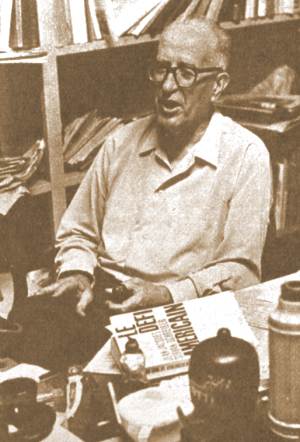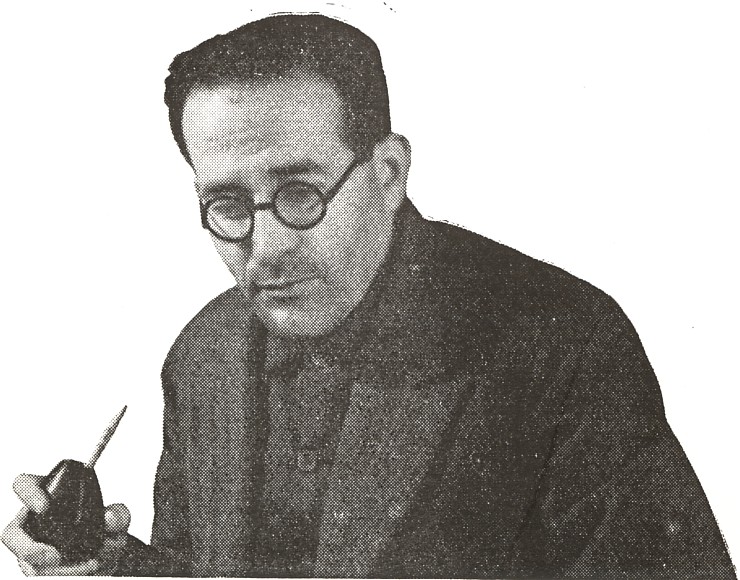<Back to Index>
- Literary Scholar Pietro Bembo, 1470
- Painter Henri - Edmond Cross, 1856
- Spanish Anarchist Diego Abad de Santillán (Sinesio Vaudilio García Fernández), 1897
PAGE SPONSOR


Diego Abad de Santillán (May 20, 1897 — October 18, 1983), born Sinesio Vaudilio García Fernández, was an author, economist and leading figure in the Spanish and Argentine anarchist movements.
Born in Reyero, a mountain village in the province of León in northwestern Spain, in 1897, Santillán emigrated at the age of eight with his parents to Argentina. From the age of ten he was attending night school, while working during the day at a variety of jobs, in particular on the railways. He returned to Spain in 1912, studying for his baccaralaurate in León, before entering the University of Madrid in 1915 to read Philosophy and Literature. After the General Strike of 1917 he was imprisoned in Madrid, where he came into contact with the anarchist movement in the person of Tomás Herreros - and then, after release under amnesty in 1918, returned to Argentina, working as an activist for the anarcho - syndicalist Federación Obrera Regional Argentina (FORA), and editing its weekly newspaper La Protesta.
In 1922 Santillán represented FORA at the formation of the anarcho - syndicalist International Workingmen’s Association (IWMA) in Berlin; while there he began to study Medicine, and came to know Elise Kater, who was to become his wife. The first of many works on the history and theory of anarchism were published at this time – Ricardo Flores Magón: Apostle of the Mexican Social Revolution and Anarchism in the Labour Movement both appeared in 1925.
In 1926 Santillán interrupted his studies to travel to Mexico, where he assisted the Confederación General de Trabajadores (CGT). Returning to Argentina, he continued his work for La Protesta, as well as for a new journal, La Antorcha, and completed The Anarchist Movement in Argentina: From Its Beginnings to 1910 (1930). In the late 1920s Santillán was a fierce opponent of the anarchist Severino Di Giovanni, whose advocation of propaganda of the deed led to a number of deaths.
When, in 1930, he was condemned to death for sedition, Santillán escaped to Uruguay. From there he travelled to Spain on the proclamation of the Republic in 1931, before returning to Argentina in secrecy to continue his militant activities and writing, including The Bankruptcy of the Capitalist Economic and Political System (1932), The Ideology of FORA and Trajectory of the Revolutionary Labour Movement in Argentina (1933) and Social Reconstruction: Foundations for a New Economic Structure in Argentina (1933). But by the end of 1933, he had returned once again to Spain, settling down in Barcelona. The following year, Santillán began work for the Federación Anarquista Ibérica (FAI), becoming, in 1935, secretary to its Peninsular Committee, and editor of Solidaridad Obrera and Tierra y Libertad; he also founded three new journals during this period: Tiempos Nuevos, Butlletí de la Conselleria d’Economia and Timón. After the Revolution in
July 1936, he represented the FAI on the Comité de
Milícies Antifeixistes de Catalunya, which co-ordinated the
various militias in Catalonia - and which formed, in the early years of the Civil War the de facto government
of Catalonia. Anarchist economic theory seems to have been foremost in
his mind at this time, as shown by the appearance of The Economic Organism of the Revolution (1936), published in the name of the anarchist Confederación Nacional del Trabajo (CNT); this was later to be reissued under the title After the Revolution: Economic Reconstruction in Spain Today (1937). Between December 1936 and April 1937 he served as Minister of the Economy (Conseller de Economía) for the Generalitat of Catalonia, while apparently maintaining anarchist principles of free participation in politics. He was especially critical of the government and person of Juan Negrín, and denounced the crimes of the Comintern loyal PCE (the Spanish Communist Party) in the Civil War. Two more books appeared at this time: The Revolution and the War in Spain (1938)
and a bibliography of Argentine anarchist writings (1938). In April
1938, Santillán joined the National Committee of the Antifascist
Popular Front, which formed from the union of the anarchist CNT and the
socialist UGT – but with the defeat of the Republic by Francoist forces in 1939, returned via France to Argentina. From
this point on, Santillán lived rather more obscurely, founding
several more journals, and continuing his scholarly work, including extensive collaboration on the Gran Enciclopedia Argentina, and critical analyses of the labour movement and Peronism: Why We Lost the War: A Contribution to the History of the Spanish Tragedy (1940) – later made into a film by his son, Francisco Galindo – The Crisis of Capitalism and the Mission of the Proletariat (1946), the section on Argentina in The Labour Movement: Anarchism and Socialism Vol. III (1965), Contributions to a History of the Spanish Labour Movement (1962 - 1971), From Alfonso XII to Franco: Notes on the Modern Political History of Spain (1974) and Strategy and Tactics: Yesterday, Today and Tomorrow (1976). Further unpublished works, Ideas y suggestiones para una nueva estrategía revolutionaria, (Ideas and Suggestions for a New Revolutionary Strategy) and Delincuencia política, (Political Criminality), along with the rest of his extensive archives, are held in Amsterdam at the International Institute of Social History.
Santillán returned to post - Franco Spain in 1977, at the age of 80, settling once again in Barcelona, and producing a final memoir, Memorias 1897 - 1936 (1977). He died in Barcelona on October 18, 1983.